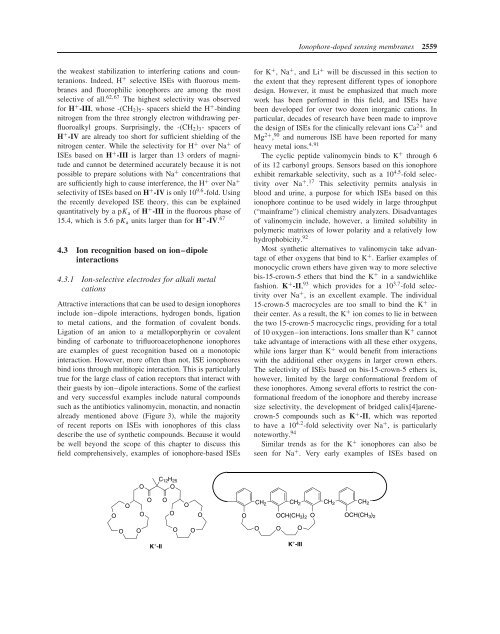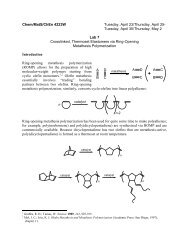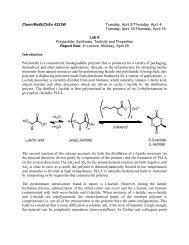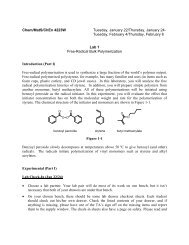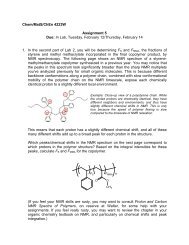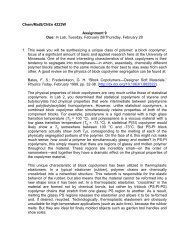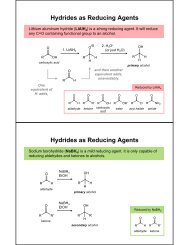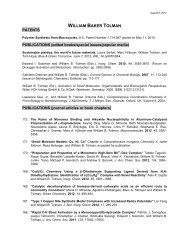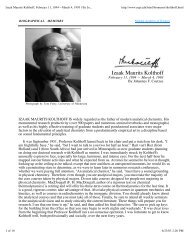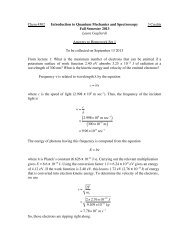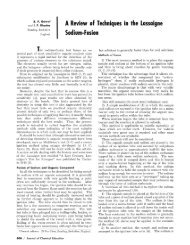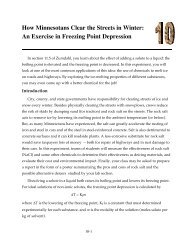Ion-Selective Electrodes With Ionophore-Doped Sensing Membranes
Ion-Selective Electrodes With Ionophore-Doped Sensing Membranes
Ion-Selective Electrodes With Ionophore-Doped Sensing Membranes
Create successful ePaper yourself
Turn your PDF publications into a flip-book with our unique Google optimized e-Paper software.
<strong>Ion</strong>ophore-doped sensing membranes 2559<br />
the weakest stabilization to interfering cations and counteranions.<br />
Indeed, H + selective ISEs with fluorous membranes<br />
and fluorophilic ionophores are among the most<br />
selective of all. 62, 67 The highest selectivity was observed<br />
for H + -III, whose -(CH 2 ) 5 - spacers shield the H + -binding<br />
nitrogen from the three strongly electron withdrawing perfluoroalkyl<br />
groups. Surprisingly, the -(CH 2 ) 3 - spacers of<br />
H + -IV are already too short for sufficient shielding of the<br />
nitrogen center. While the selectivity for H + over Na + of<br />
ISEs based on H + -III is larger than 13 orders of magnitude<br />
and cannot be determined accurately because it is not<br />
possible to prepare solutions with Na + concentrations that<br />
are sufficiently high to cause interference, the H + over Na +<br />
selectivity of ISEs based on H + -IV is only 10 9.6 -fold. Using<br />
the recently developed ISE theory, this can be explained<br />
quantitatively by a pK a of H + -III in the fluorous phase of<br />
15.4, which is 5.6 pK a units larger than for H + -IV. 67<br />
4.3 <strong>Ion</strong> recognition based on ion–dipole<br />
interactions<br />
4.3.1 <strong>Ion</strong>-selective electrodes for alkali metal<br />
cations<br />
Attractive interactions that can be used to design ionophores<br />
include ion–dipole interactions, hydrogen bonds, ligation<br />
to metal cations, and the formation of covalent bonds.<br />
Ligation of an anion to a metalloporphyrin or covalent<br />
binding of carbonate to trifluoroacetophenone ionophores<br />
are examples of guest recognition based on a monotopic<br />
interaction. However, more often than not, ISE ionophores<br />
bind ions through multitopic interaction. This is particularly<br />
true for the large class of cation receptors that interact with<br />
their guests by ion–dipole interactions. Some of the earliest<br />
and very successful examples include natural compounds<br />
such as the antibiotics valinomycin, monactin, and nonactin<br />
already mentioned above (Figure 3), while the majority<br />
of recent reports on ISEs with ionophores of this class<br />
describe the use of synthetic compounds. Because it would<br />
be well beyond the scope of this chapter to discuss this<br />
field comprehensively, examples of ionophore-based ISEs<br />
for K + ,Na + ,andLi + will be discussed in this section to<br />
the extent that they represent different types of ionophore<br />
design. However, it must be emphasized that much more<br />
work has been performed in this field, and ISEs have<br />
been developed for over two dozen inorganic cations. In<br />
particular, decades of research have been made to improve<br />
the design of ISEs for the clinically relevant ions Ca 2+ and<br />
Mg 2+ , 90 and numerous ISE have been reported for many<br />
4, 91<br />
heavy metal ions.<br />
The cyclic peptide valinomycin binds to K + through 6<br />
of its 12 carbonyl groups. Sensors based on this ionophore<br />
exhibit remarkable selectivity, such as a 10 4.5 -fold selectivity<br />
over Na + . 17 This selectivity permits analysis in<br />
blood and urine, a purpose for which ISEs based on this<br />
ionophore continue to be used widely in large throughput<br />
(“mainframe”) clinical chemistry analyzers. Disadvantages<br />
of valinomycin include, however, a limited solubility in<br />
polymeric matrixes of lower polarity and a relatively low<br />
hydrophobicity. 92<br />
Most synthetic alternatives to valinomycin take advantage<br />
of ether oxygens that bind to K + . Earlier examples of<br />
monocyclic crown ethers have given way to more selective<br />
bis-15-crown-5 ethers that bind the K + in a sandwichlike<br />
fashion. K + -II, 93 which provides for a 10 3.7 -fold selectivity<br />
over Na + , is an excellent example. The individual<br />
15-crown-5 macrocycles are too small to bind the K + in<br />
their center. As a result, the K + ion comes to lie in between<br />
the two 15-crown-5 macrocyclic rings, providing for a total<br />
of 10 oxygen–ion interactions. <strong>Ion</strong>s smaller than K + cannot<br />
take advantage of interactions with all these ether oxygens,<br />
while ions larger than K + would benefit from interactions<br />
with the additional ether oxygens in larger crown ethers.<br />
The selectivity of ISEs based on bis-15-crown-5 ethers is,<br />
however, limited by the large conformational freedom of<br />
these ionophores. Among several efforts to restrict the conformational<br />
freedom of the ionophore and thereby increase<br />
size selectivity, the development of bridged calix[4]arenecrown-5<br />
compounds such as K + -II, which was reported<br />
to have a 10 4.2 -fold selectivity over Na + , is particularly<br />
noteworthy. 94<br />
Similar trends as for the K + ionophores can also be<br />
seen for Na + . Very early examples of ISEs based on<br />
O<br />
C 12 H 25<br />
O<br />
O<br />
O<br />
O<br />
O<br />
O<br />
O<br />
O<br />
O<br />
CH 2 CH 2 CH 2 CH 2<br />
O OCH(CH 3 ) 2 O OCH(CH 3 ) 2<br />
O<br />
O<br />
O<br />
O<br />
O<br />
O<br />
O<br />
K + -II<br />
K + -III


